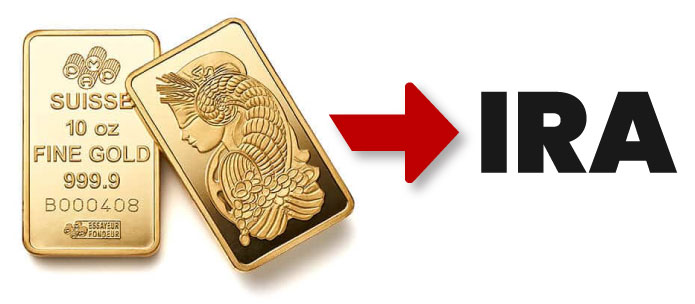Learning
Tax Implications of Investing in a Gold IRA

Investing for the future is an essential part of any financial strategy. And while there are many options available, one that has gained popularity over the years is investing in a gold IRA. Not only does this investment provide a tangible asset, but it also offers unique tax advantages that can help grow your wealth even further.
So, let’s dive into the fascinating world of precious metals IRAs and explore the tax implications that make them such an intriguing investment choice.
What is a gold IRA?
Before we delve into taxes, it’s vital to understand what a gold IRA actually is. Unlike traditional Individual Retirement Accounts (IRAs) that invest in stocks or bonds, a gold IRA involves owning physical gold bullion or coins within a qualified retirement account. This provides you with the reassurance that your retirement savings are backed by something solid and not just paper promises.
Tax-Deferred Growth
Now here’s the exciting part – when you invest in a gold IRA, you can enjoy tax-deferred growth on your investment. That means no immediate taxes on any gains made from your gold holdings within your IRA. Just like how Bond films keep us on our toes until the credits roll, you get to keep more money growing in your account until you start taking withdrawals during retirement.
However, don’t forget about good old Uncle Sam – he’ll come knocking eventually! When you do take distributions from your gold IRA during retirement, they will be taxed as ordinary income at your marginal tax rate then.

Diversification and Lower Taxes
You might be thinking: “But regular IRAs offer diversification too!” True, but investing in physical gold offers even more diversification benefits as it moves independently from traditional markets like stocks and bonds. Having some glittering gold as part of your retirement portfolio gives you an added layer of protection against market volatility and currency devaluation.
And you know what else? Your precious metals are classified as collectibles by the IRS. Why is that important? Well, when collectibles are held outside of an IRA, they can be subject to a special ‘collectibles tax’ rate of up to 28%. By keeping them within a gold IRA, you avoid this higher tax rate. So not only do you get diversification through precious metals, but you also get a potentially lower tax bill!
Early Withdrawals and Taxes
Now let’s discuss the elephant in the room – early withdrawals. What happens if you need some extra cash and decide to take money out of your gold IRA before reaching the ripe retirement age?
Generally speaking, if you withdraw from your Traditional or Roth IRA before turning 59 ½ years old, you may be subject to a 10% early withdrawal penalty along with taxes owed on the amount taken out. However, with a gold IRA, it’s slightly different.
Under specific circumstances, the IRS allows for penalty-free early withdrawals from your gold IRA called “exceptions.” Some examples include paying for medical expenses or health insurance premiums while unemployed. In these cases, although taxes will still apply to the withdrawn amount (because remember – it’s tax-deferred growth), at least Uncle Sam won’t give you an extra smack on the wrist in the form of penalties.

Gold Redemption and Taxes
Eventually, there comes a time when all good things must come to an end. When you’re ready to retire and start taking distributions from your gold IRA account as regular income – here comes taxation once again!
The value of gold in your account at redemption time will determine how much taxable income is generated. Remember though; this only applies when gold is physically redeemed as part of your distribution strategy – be it through outright purchases or by selling pieces over time.
It’s important to keep track of any changes in IRS regulations that might affect taxation rates applicable during redemption since these can change over time.
How to Move IRA or 401(k) to Gold Without Penalty?
If you’re considering moving your IRA or 401(k) into a gold IRA, you may wonder about the process and if there are any penalties involved. The good news is that you can make this transfer without facing any immediate tax penalties by following a few simple steps.
Choose a Custodian
The first step is to select a reputable custodian who offers gold IRA services. Make sure to do your research and choose a custodian with experience in precious metals investing and solid customer reviews.
Open a gold IRA Account
Once you’ve chosen a custodian, you’ll need to open a gold IRA account with them. This usually involves completing some paperwork and providing necessary identification documents.
Fund Your New gold IRA
After opening your gold IRA account, you’ll need to fund it by transferring funds from your existing IRA or 401(k) plan. This process can be done through a direct rollover, where the funds go directly from one custodian to another without passing through your hands.
Choose Your Precious Metals
With your new gold IRA funded, it’s time to decide which precious metals you want to invest in. You can choose from gold bullion bars or coins, silver bullion bars or coins, platinum bars or coins, or even palladium bars or coins. Be sure to consult with your custodian on the acceptable types of precious metals for your gold IRA.
Purchase Approved Precious Metals
Once you’ve made your selection, inform your custodian of the types and quantities of precious metals you wish to purchase for your account. They will handle the purchase on your behalf from an approved dealer using funds from your newly established gold IRA.
Storage & Maintenance
As per IRS rules, the physical gold purchased through a gold IRA must be stored in an approved depository facility operated by an independent trustee or third party custodian — not in any personal safe at home. Your custodian will arrange for secure storage of your precious metals and handle any necessary maintenance or insurance.
It’s worth noting that while there are no immediate tax penalties when moving your IRA or 401(k) to a gold IRA, you should be aware of the potential taxes and penalties that may arise if you decide to take early distributions from your gold IRA before reaching retirement age.
To ensure a smooth transition and avoid any inadvertent tax consequences, it’s always wise to consult with a qualified financial advisor or tax professional who can guide you through the process and help you make informed decisions aligned with your individual financial goals.
In Conclusion
Moving your IRA or 401(k) to a gold IRA allows you to diversify your retirement portfolio with tangible assets while potentially enjoying certain tax advantages. With proper planning, consideration of gold IRA pros and cons, and working closely with a trusted custodian, you can transfer funds into a gold IRA without incurring any penalties. So why not explore this option and see if it aligns with your long-term financial objectives?
Investing in a gold IRA not only offers a unique and tangible asset for your retirement portfolio but also comes with several tax advantages. The ability to grow your investment on a tax-deferred basis, diversify your holdings, potentially lower your taxes, and even enjoy penalty-free early withdrawals under certain circumstances makes a gold IRA an attractive option.
Remember to consult with a qualified financial advisor or tax professional who can guide you through the intricacies of investing in a gold IRA and help you make decisions aligned with your individual financial goals.

Learning
First-Time Buyer’s Guide to the UK Property Market

Entering the UK property market as a first-time buyer can feel both exciting and daunting. The process is filled with potential pitfalls and complex decisions, but with the right guidance, it can be navigated smoothly. The estate agents in Yorkshire demystify the journey from the initial decision to buy a home to the moment you step over the threshold of your new property.
Understanding Your Financial Position
The first and perhaps most crucial step in the home-buying process is understanding your financial situation. This includes assessing your savings, income, and current debts. Here’s how you can prepare:
1. Deposit: Generally, you’ll need at least 5% of the property price as a deposit, though aiming for 10% or more can provide better mortgage rates.
2. Income and Expenses: Use a budget planner to assess your monthly income against your expenses. This will help you understand how much you can afford in monthly mortgage repayments.
3. Credit Score: Lenders will evaluate your credit score to determine your mortgage eligibility. So it’s important to have a good credit score, and you should work on it if required.
4. Mortgage Options: Speak to a mortgage advisor to understand different types of mortgages, such as fixed-rate, variable-rate, and help-to-buy schemes.
Getting a Mortgage Agreement in Principle
A Mortgage Agreement in Principle (AIP) is a statement from a lender indicating how much they’ll likely lend you. You will be a more attractive buyer with an AIP as it shows sellers you’re serious and financially prepared.
Deciding What You Want
Before you start viewing properties, it’s essential to know what you’re looking for. Consider the following factors:
1. Location: Proximity to work, schools, public transport, and amenities are key. Research neighbourhoods to find the best fit for your lifestyle.
2. Property Type: Decide whether you want a flat, terraced house, semi-detached, or detached property. Each has its pros and cons.
3. Must-Haves: Make a list of non-negotiables, such as the number of bedrooms, garden size, and parking facilities.
4. Future Proofing: Consider your future needs. Are you planning to start a family? Do you need space for a home office?
Starting the Property Search
With a clear idea of what you’re looking for, you can begin your property search. Here are some tips:
1. Use Online Portals: Websites like Rightmove, Zoopla, and OnTheMarket are excellent starting points. Set up alerts to get notified of new listings that meet your criteria.
2. Visit Estate Agents: Register with local estate agents who can provide insights into the market and inform you of new properties before they’re listed online.
3. Attend Viewings: Don’t rush this part. Visit several properties to get a feel for what’s available in your price range.
Making an Offer
Once you find a property you love, it’s time to make an offer. Here’s how to approach it:
1. Research: Check the selling prices of similar properties in the area to gauge a fair offer.
2. Negotiate: Don’t be afraid to negotiate. The starting point is most usually the asking price.
3. Conditions: You might include conditions in your offer, such as the inclusion of certain fixtures or a specific moving date.
The Legal Process
If your offer is accepted, the legal process begins. You’ll need a solicitor or licensed conveyancer to handle the legalities. Here’s what to expect:
1. Conveyancing: This is the legal transfer of property ownership. Your solicitor will handle this, including conducting searches, dealing with the Land Registry, and transferring the funds.
2. Surveys and Inspections: Arrange for a property survey to check for structural issues. There are different types of surveys, from basic condition reports to full structural surveys.
3. Mortgage Finalisation: Once the survey is complete and satisfactory, your mortgage can be finalised.
4. Exchange of Contracts: This is when the sale becomes legally binding. You’ll pay your deposit at this stage.
5. Completion: On the agreed completion date, the remaining money is transferred, and you receive the keys to your new home.
Moving In
Moving day can be hectic, but planning can ease the stress:
1. Hire a Removal Company: Book a reliable removal company well in advance. Discover the best deals by getting quotes from multiple companies.
2. Pack Strategically: Label your boxes by room and keep essential items accessible.
3. Notify Utilities and Change Address: Inform your utility providers of your move date and update your address with banks, the DVLA, and other important institutions.
Settling In
Get settled. Introduce yourself to the neighbours, familiarise yourself with the local area, and really start to make the place your own.
Here are a few final tips:
1. Safety Checks: Make sure that your smoke alarms and carbon monoxide detectors are working, and make sure that you know where the gas and electricity meters are located.
2. Maintenance Plan: Keep a record of the smooth functioning of your new home with a maintenance schedule, complete with regular checks and seasonal tasks.
3. Personal Touches: Add personal touches to make the space feel like home. This can be from putting up family photos or redoing the decoration in your rooms.
Conclusion
Buying your very first home in the UK is most definitely a milestone, difficult and full of challenges but rewarding in the end. Such a philosophy guides you in understanding finances and knowing what you want to achieve from detailed research, and seeking professional advice that confidently helps you navigate the property market. Yes, the journey may have its hurdles, but in the end—owning your own home—the reward will be worth the effort. Welcome to your new chapter!
SEE ALSO: Conquer the Chaos: Hacks to Clean Your Home in Half the Time
Learning
5 Health Benefits of Regular Pedicures

There’s nothing quite like a pedicure to keep your feet looking and feeling their best, but did you know that pedicures do more than simply enhance the appearance of your feet? Many people don’t realize that regular pedicures can come with a wide range of health benefits that can promote the well-being of your feet, so here are some ways that your routine pedicure keeps both your toenails and feet in the best condition possible!
Smoother Skin
One of the biggest misconceptions about pedicures is that they only cater to and look after your toenails. While you’ll definitely be leaving each session with a fresh coat of nail polish, your pedicure can also do wonders for the health of your skin. Aside from trimming and shaping your nails and cuticles, you’ll notice that your nail technician also dedicates a few steps to the skin of your feet.
After inspecting your feet and looking for any issues or imperfections that may need to be addressed, your technician will work on an exfoliating scrub to remove any dead skin cells. This step may also be aided by a foot file, which can be used to buff away any calluses and other problem areas manually.
Softer Skin
After your nail technician addresses all the problem areas of your feet and removes any unwanted dead skin cells, he or she will often massage in a moisturizing product, such as lotion, cream, or butter, to ensure that your skin is properly moisturized. These products contain skin-loving ingredients that will ensure that your feet have everything they need to look and feel their best so that you can walk out of your pedicure with a renewed sense of confidence.
Healthier Nails
After your pedicure session, your nails will not only look better due to the fresh coat of nail polish, but they’ll also be healthier and stronger. This is because your nail technician takes their time to ensure that your nails are properly looked after through steps that include deep cleaning, nail trimming, nail filing, and cuticle care. All of these things work together to prevent issues like ingrown nails from occurring, all the while improving the appearance of your nails.
Increased Blood Circulation
While the specific steps included in your pedicure will depend on the beauty salon, most pedicures will have a massage step somewhere in the mix. One of the often overlooked benefits of these massages is the increased blood circulation, which can deliver more nutrients and oxygen to your feet and nails, promoting their health and appearance. Aside from that, better blood flow means reduced tension and soreness, as well as better distributed heat throughout your body.
Reduced Infections
A significant amount of dirt and bacteria can build up on your feet without you even realizing it, but pedicures can be a great way to prevent these from happening in the first place. The exfoliation step of a pedicure removes dead skin cells as well as all the debris that may have accumulated underneath, and the deep cleaning of your toenails and cuticles also gets rid of any impurities that may have slipped beneath them, which can stop infections from happening.
These are some of the many health benefits that you can look forward to at your next pedicure appointment. However, it’s worth noting that you need to book regular sessions to truly reap all the rewards. This can be difficult, especially when you don’t feel like driving to your nearest nail salon after a long day, but the good news is that you can enjoy the salon experience in the comfort of your own home with a home pedicure service.
Learning
Commercial Boiler Installation Services London

For businesses in the bustling city of London, having a reliable heating system is crucial. Whether you’re opening a new office, expanding your current premises, or simply upgrading an outdated system, commercial boiler installation services for businesses in London are essential to ensure your operations run smoothly and efficiently. Proper installation and maintenance of commercial boilers can make a significant difference in energy efficiency, cost savings, and the overall comfort of your workspace.
The Importance of Professional Installation
When it comes to installing a commercial boiler, professional expertise is paramount. Here’s why:
- Efficiency and Performance: Professional installation ensures that your boiler operates at peak efficiency, reducing energy consumption and lowering utility bills. A well-installed boiler can effectively meet the heating demands of your business without unnecessary energy waste.
- Safety: Commercial boilers are complex systems that require precise installation to operate safely. Professional installers adhere to stringent safety standards and regulations, minimizing the risk of accidents and ensuring the safety of your employees and premises.
- Compliance with Regulations: Commercial properties are subject to various building codes and regulations. Professional installers are well-versed in these requirements and ensure that your boiler system complies with all local laws and standards.
- Longevity and Reliability: Proper installation is critical to the longevity and reliability of your boiler. A professional installation can prevent common issues such as leaks, pressure problems, and system failures, ensuring that your boiler runs smoothly for years to come.
Key Considerations for Commercial Boiler Installation
When planning for a commercial boiler installation, several factors need to be considered:
- Type of Boiler: The type of boiler you choose will depend on your business’s specific needs. Options include gas boilers, oil boilers, and electric boilers, each with its own set of advantages. Consulting with a professional can help you determine the best choice for your business.
- Sizing and Capacity: The boiler’s size and capacity must match the heating demands of your commercial space. An undersized boiler will struggle to meet your needs, while an oversized one will lead to inefficiencies and higher costs.
- Location: The placement of your boiler affects its efficiency and accessibility for maintenance. Professional installers can help you choose the optimal location for your boiler.
- Integration with Existing Systems: If you’re upgrading or replacing an existing boiler, it’s essential to ensure compatibility with your current heating system. Professional installers can seamlessly integrate the new boiler with your existing setup.
Choosing the Right Installation Service

Selecting the right installation service provider is crucial to the success of your boiler installation project. Consider the following when making your choice:
- Experience and Expertise: Look for a provider with a proven track record in commercial boiler installations. Experienced installers can handle the complexities of commercial systems and provide high-quality workmanship.
- Reputation: Check reviews and testimonials from previous clients to gauge the provider’s reliability and customer satisfaction.
- Comprehensive Services: Choose a provider that offers a full range of services, including installation, maintenance, and repair. This ensures that all your boiler needs are met by a single, trusted source.
In London, ROWLEN is a reputable name known for delivering top-notch commercial boiler installation services. Their team of experts is dedicated to providing efficient, safe, and compliant installations tailored to the unique needs of businesses.
Conclusion
Investing in professional commercial boiler installation services for businesses in London is essential for ensuring efficiency, safety, and long-term reliability. By choosing an experienced and reputable service provider like ROWLEN, you can rest assured that your heating system will be installed correctly and maintained to the highest standards. Proper installation not only enhances the performance of your boiler but also contributes to the overall comfort and productivity of your business environment.
SEE ALSO:
-

 News4 years ago
News4 years agoLet’s Know About Ultra High Net Worth Individual
-
Entertainment2 years ago
Mabelle Prior: The Voice of Hope, Resilience, and Diversity Inspiring Generations
-
News11 years ago
Enviromental Groups Tell Mekong Leaders Lao Dam Evaluation Process Flawed
-

 Health4 years ago
Health4 years agoHow Much Ivermectin Should You Take?
-

 Tech3 years ago
Tech3 years agoTop Forex Brokers of 2023: Reviews and Analysis for Successful Trading
-

 Lifestyles3 years ago
Lifestyles3 years agoAries Soulmate Signs
-

 Entertainment3 years ago
Entertainment3 years agoWhat Should I Do If Disney Plus Keeps Logging Me Out of TV?
-

 Health3 years ago
Health3 years agoCan I Buy Ivermectin Without A Prescription in the USA?
